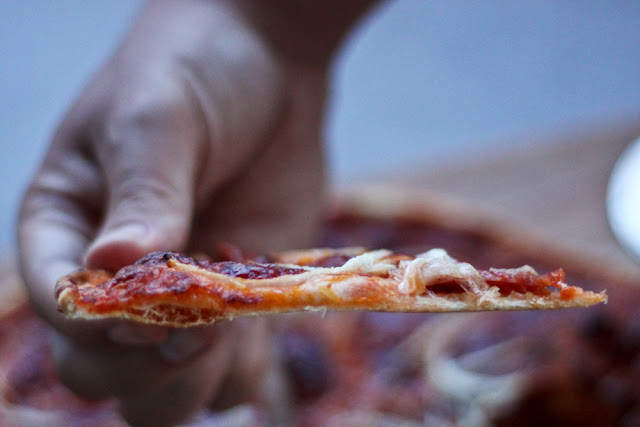Japanese milk bread (shokupan)
Japanese milk bread is like eating clouds of bread. But it's not only light, fluffy, and tender—its ridiculously delicious.
You'll find approximately 203496767209462340 recipes for this amazing bread on the internet, so I cannot say this is the best or the most authentic. (I am also far from a bread expert!) But it turned out a seriously impressive loaf, so I want to document this hybrid recipe, even if I end up tweaking it in the future. I mean just look at it!

I've noticed that the recipes out there for milk bread fall into 2 buckets: those that use the tangzhong method and those that don't. This recipe does, as that seems to be more true to the original. And the benefit of tangzhong is that it makes for a moister bread that will stay fresher for longer.
My loaf pan may have been a leeeeetle small for the bread. Or I may not have rolled up the bread as tightly as I should have (or maybe I rolled it too tightly?), as it expanded in a weird way on one side of the loaf. I like to call this a "business in the front / party in the back" loaf!
Japanese Mild Bread, adapted from Caroline's Cooking, Little Epicurean, and Food 52
The "finger poke test" is how you'll test to see if your bread is proofed enough. To test your dough, press it lightly with your knuckle or finger.
- If the dent slowly springs back, that's perfect!
- If the dent completely/quickly springs back, it's not done proofing yet.
- If the dent remains and doesn't spring back at all, the dough is over-proofed
Any regular sized loaf pan (around 9x4" or 9x5") will work for this recipe. Your loaf may just rise up higher with a smaller pan like mine did.
Ingredients
Tangzhong
6 TBSP water
2 TBSP bread flour
Bread
1/2 cup milk, room temperature
1 egg, room temperature
325 g bread flour (2.5 cups)
2 tsp instant yeast
1 TBSP milk powder (optional)
1 tsp salt
3 TBSP sugar
2 TBSP butter (30 g), softened
egg wash (1 egg whisked with a splash of water or milk)
Directions
- Make tangzhong: In a small saucepan, whisk together water and bread flour until smooth and no lumps remain. Heat mixture over medium-low, whisking constantly. Cook until it has thickened to a gel-like consistency, about a few minutes. It's ready once you see trails left by the whisk as you stir. Transfer to a medium bowl and cool completely to room temperature.
- Make bread: To your reserved tangzhong add the milk and egg. Mix well.
- In the bowl of a stand mixer, whisk together bread flour, yeast, milk powder (if using), salt, and sugar. Attach dough hook to mixer.
- Add the wet tangzhong/milk/egg mixture to the dry ingredients. Knead on low for 5 minutes.
- Add softened butter in 2 batches (1 TBSP at a time), and knead on low for an additional 5 minutes, making sure the butter is evenly mixed into the dough.
- Knead for an 5 additional minutes, either by hand or on medium speed until dough is smooth (and pulls away the bowl if using the mixer).
- Proof #1: Transfer dough to a greased bowl, cover with plastic wrap, and let rise until doubled in volume, 1+ hours. (The Food52 recipe says you can also do an overnight proof in the refrigerator. Though I didn't try this method, this is a great way to split up the recipe across two days)
- Shape dough: Turn out the dough onto a lightly floured surface and gently deflate the dough. Divide dough into 4 equal-sized pieces and roll into balls. Make sure to keep your dough covered with plastic wrap as you work with each ball.
- Roll out each ball of dough into a rectangle, about 8" tall and 5" wide (1st pic below). Fold the piece lengthwise into thirds (2nd pic). Then flatten it into a rectangle about 9" tall and about as wide as your loaf pan (3rd pic). Finally, roll up the dough (4th pic) and place in your pan, seam side down.
- Proof #2: Repeat with remaining dough balls. Cover loaf pan with plastic wrap and let it proof until it nearly doubles in volume, about 40 to 60 minutes. It's ready when it passes the poke test. About 20 minutes before your bread is done proofing, preheat the oven to 350° F.

Pre-proof 
Post-proof - Bake: Lightly brush your dough with egg wash, taking care not to press too hard and deflate the proofed dough. Bake for about 30 to 40 minutes, or until it is golden brown on top and reaches an internal temperature of 190° F. If the bread is browning too quickly and isn't done yet, tent with foil.
- Cool in the loaf pan for 5 minutes. Remove from pan and allow to cool completely to room temperature on a wire rack. I know it's suuuuuper tempting to stuff some warm bread in your mouth, but it's best to let the bread cool completely so you don't end up with a doughy, gummy loaf.












Comments
Post a Comment